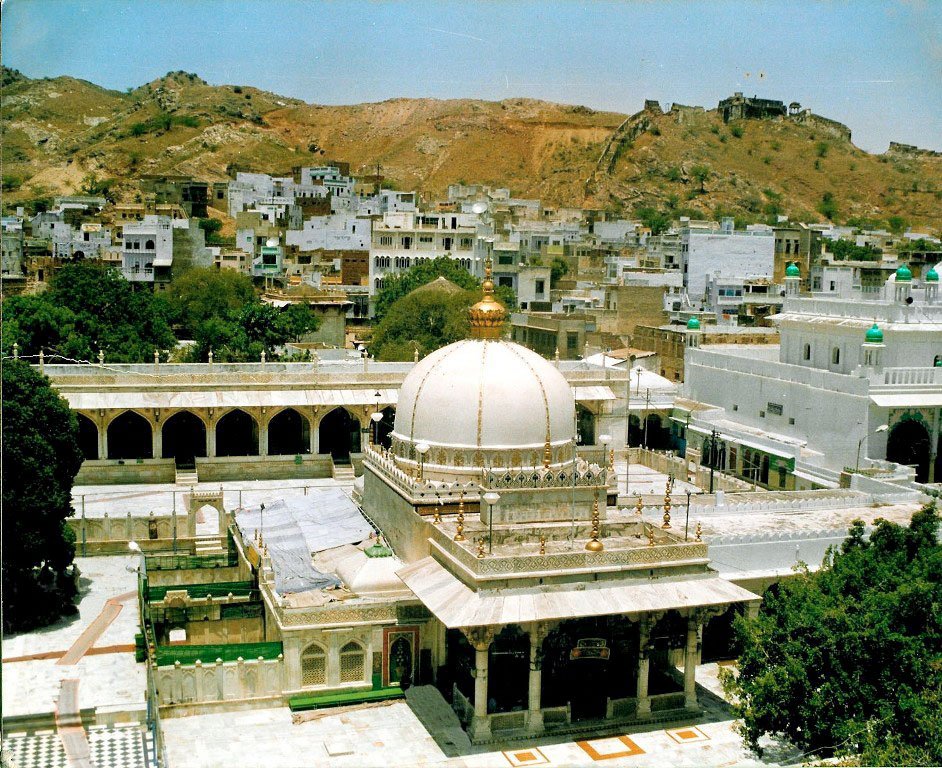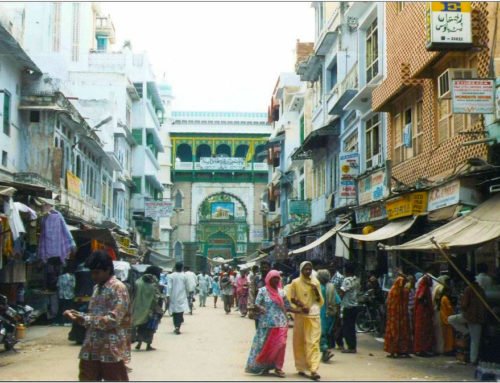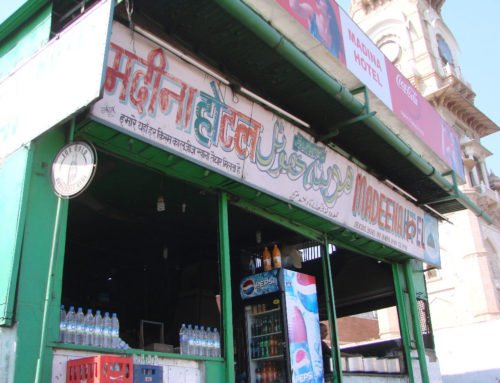Overview
- Features: A Sufi shrine dedicated to Moinuddin Chishti with his tomb enclosed within
- Opening Times: 4am to 9pm (summer); 5am to 9pm (winter), daily
- Best Time to Visit: Late October to early March
- Duration: Half a day
- Travelled By: Bus
- Cost: Free; donation at tomb
- Address: Andar Kot Road, Ajmer, Rajasthan, India
- Type: Shrine
Author Reviews[display_rating_item_results rating_form_id=”2″ rating_entry_ids=”1″ show_category_filter=”false” show_options=”true” result_type=”star_rating” preserve_max_rating=”true” show_title=”false” show_count=”false” ]
Total Rating: [display_rating_result rating_form_id=”2″ show_count=”false” show_rich_snippets=true] [accordions load=”1″] [accordion title=”User Reviews” last] [display_rating_item_results rating_form_id=”5″ show_options=”true” result_type=”star_rating” preserve_max_rating=”true” show_title=”false” show_count=”true” show_rich_snippets=true] [/accordion] [accordion title=”Add Review”][display_rating_form show_email_input=”true” show_comment_textarea=”true” show_name_input=”true” rating_form_id=”5″] [/accordion] [/accordions]
Summary
If you’re planning a visit to Ajmer Sharif Dargah you should read this article which provides information on what you can expect to see and experience on a visit to the dargah. Plus, find out the best time to visit, the history and frequently asked questions about Ajmer Sharif Dargah Rajasthan.
What to Expect on a Visit to Ajmer Sharif Dargah Rajasthan
Ajmer Sharif Dargah History
Ajmer Sharif, is a Sufi dargah or shrine, dedicated to Khwaja Moinuddin Chishti, founder of the Chishtiya Sufi order in India. The shrine has the maqbara (tomb) of the revered saint. He came to Ajmer from Persia in 1192 and died here in 1236. It was here that Moinuddin Chishti laid the permanent foundation of Islam in India in 1192 by his spiritual powers and peaceful preachings.
Ajmer Sharif attracts millions of people every year to seek spiritual blessings of the great saint. The most important time of the year is during the Urs festival. It is an annual festival, which commemorates the death anniversary of Moinuddin Chishti. It is held over six days and features night-long qawwali (devotional music) singing. The anniversary is celebrated in the seventh month of the Islamic lunar calendar. Thousands of pilgrims visit the shrine from all over India and abroad.
The reason we went to Ajmer Sharif was to see the architectural structure of the building, however the experience that we came away with was more deeper than that. Ajmer Sharif was packed with hundreds of pilgrims on the day. On later research, we found out that we had visited Ajmer Sharif during the festival of Muharram, the first month of the Islamic calendar, and considered the most sacred of all months after Ramadan.
Best Time to Visit Ajmer Sharif Dargah
While the best times to visit the Dargah is during the Urs festival, Muharram or Ramadan, it gets extremely crowded and hard to move around. However, the atmosphere at this time is the best, as the sense of worship and homage to the Saint is as strong as the scent of the sandalwood and perfumes in front of his tomb.
Ajmer Sharif Map
[singlepic id=2953 w=720 h=560 float=center]
Ajmer Sharif is a big enclosure consisting of several gates, degs (cauldrons) and mosques, in addition to the tomb of Moinuddin Chishti. The map above shows the layout of Ajmer Sharif, and the progression through to various points of interest. It starts with the road from the railway station that leads west to Ajmer Sharif, and ends at the Sai Ghat at the southern end of the enclosure.
Information About Ajmer Sharif Dargah Rajasthan
Before entering Ajmer Sharif, it is required that both men and women cover their heads with a cap or scarf as a sign of respect to the religious site being entered. Shoes, bags and cameras need to be left outside before entering Nizam Gate. There is a cloak room to the right of the entrance, where you can leave your bags and shoes for a small fee.
First Gate – Nizam Gate
[singlepic id=2948 w=720 h=560 float=center]
The main entrance to Ajmer Sharif is via the Nizam Gate. It is the first of three gate into Ajmer Sharif, and stands at a height of 60 feet. It was erected by Mir Osman Ali Khan, the then Nizam of Hyderebad Deccan in 1911. It is built up some steps to protect it from the rains.
There are two separate lines for men and women to enter Ajmer Sharif via Nizam Gate.
There is a green and white mosque on the right, Akbari Masjid, which was constructed by Akbar in 1571. It is now Moiniua Usmania Darul-Uloom, an Arabic and Persian school for religious education.
Second Gate – Shahjahani Gate
[singlepic id=2944 w=720 h=560 float=center]
The second gate inside Ajmer Sharif is the Shahjahani Gate, which was erected by Mughal emperor, Shah Jahan. It is often called Nakkarkhana as it has two large nakkharas (drums) fixed above it. These drums are used to sound the beginning of the Urs festival.
In front of this gate, there are several shops selling flowers and offerings for worshipers to take inside and place on the tomb of Moinuddin Chishti. They also sell beautiful religious sheets inscribed with religious verses from the Koran.
Third Gate – Buland Darwaza
[singlepic id=2959 w=720 h=560 float=center]
The third and final gate is the Buland Darwaza, upon which the Urs flag is hoisted, marking the beginning to the tomb of Moinuddin Chishti.
The Buland Darwaza is the last gate before the entrance to the tomb of Moinuddin Chishti. It is also the tallest of the gates, standing at 80 feet high. It was erected either by Mahmood Khilji or one of his successors in the 16th century.
Ajmer Sharif Deg (Iron cauldron)
[singlepic id=2961 w=720 h=560 float=center]
On either side of the second Buland Darwaza in front of Saham Chiragh (courtyard lamp), there are two huge degs (iron cauldrons for cooking food) fixed into the ground, in which a mixture of rice, sugar, ghee (butter) and dried fruits is cooked for distribution to the public as tabarruk (blessings).
The larger cauldron cooks 70 mounds of rice, while the smaller one takes 28 mounds. One of them was presented by Akbar in 1567 and the other by Jehangir in 1631. The princes or the richer pilgrims order these degs to be cooked generally during the Urs period.
Begami Daalaan Porch
[singlepic id=2956 w=720 h=560 float=center]
Construction of the shrine was completed by emperor Humayun. Overhanging the entrance to the shrine, there is a beautiful porch known as Begami Daalaan which was built in 1643 by Princess Jahan Ara Begam, the favorite daughter of Emperor Shah Jahan. This is the most beautiful part of the entire Dargah and my favourite area.
The walls and the beautiful marble pillars of the Begami Daalaan were done in colorful gold in 1888. Later on, the ceiling of this Daalaan was also embellished in gold with the money donated by a Muslim merchant of Bombay. This beautiful portico was used by the Begams or ladies of the Moghul harem during their frequent visits to the shrine.
There are two simultaneous entrances to the shrine through the Begami Daalaan. The doors of both of them are mounted with heavy silverplate carved with ornamental details.
Ajmer Sharif Shrine of Khawaja Moinuddin Chishti
[singlepic id=2943 w=720 h=560 float=center]
The tomb is made of white marble, inlaid with pieces of precious stones, and is daily covered with sandalwood paste and ittars (perfume oils). It is always covered with very costly ghilaafs (coverings made of velvet and silk), embroidered with gold and silver threads. The ceiling of the dome is also covered by a costly velvet chatgiri (covering).
Over the tomb, there is a silver chaparkhat (canopy) inlaid with pieces of mother-of-pearl, presented by emperor Jahangir. Between the four poles supporting the chaparkhat, there is silver katehra (railing) with an arch towards the south. There is another outer silver katehra running around the tomb at a distance of about 2 feet.
We were led into the shrine to offer flowers and prayers over the tomb. We had to walk anti-clockwise around the tomb as quickly as possible. A fascinating aroma of sandalwood and perfume wafted towards us inside the shrine, which seemed to inspire the worshippers with a strong feeling of devotion and homage towards the saint. There was a lot of chanting and prayers being conducted inside the shrine, which created a strong atmosphere of reverence.
Devotees believe that the saint’s spirit will intercede on their behalf in matters of illness, business or personal problems, so the notes and holy strings attached to the railings around the tomb are thanks or requests.
Shah Jahani Mosque
[singlepic id=2962 w=720 h=560 float=center]
At the southern end of the shrine stands the Jama Masjid or Shah Jahani Mosque, which is a fine piece of Mughal architecture. All the 99 sacred names of Allah with 33 Quranic verses are beautifully inscribed in the mosque.
While Graham really enjoyed the entire experience, I found it quite overwhelming. Being crushed and pushed along with hundreds of devotees for an hour or more was mentally debilitating to say the least. However, Graham absorbed the atmosphere inside the Shrine, and it had a bigger impact on him. After our visit to Ajmer Sharif, Graham has a strong desire to visit Mecca and Medina in Saudi Arabia in the not-to-distant future.
FAQ’s About Ajmer Sharif Dargah
Below are answers to some frequently asked questions about Ajmer Sharif Dargah. If you have any other questions, please leave your question in the Comments section below.
What is Ajmer Sharif?
Ajmer Sharif is a a Sufi dargah or shrine, dedicated to Khwaja Moinuddin Chishti, founder of the Chishtiya Sufi order in India. The shrine has the maqbara (tomb) of the revered saint.
Ajmer Sharif Dargah Timings
Ajmer Sharif Dargah is open daily from 4am to 9pm in summer and 5am to 9pm in winter.
Where is Ajmer Sharif located?
Ajmer Sharif is located in the Rajasthani city of Ajmer in Northern India.
Distance from Pushkar to Ajmer Sharif
Ajmer Sharif is located 14km southeast of Pushkar.
Distance from Jaipur to Ajmer Sharif
Ajmer Sharif is located 131km southwest of Jaipur.
Distance from Delhi to Ajmer Sharif
Ajmer Sharif is located 387km southwest of Delhi.
How to reach Ajmer Sharif?
Depending on where you’re travelling from in India, Ajmer Sharif can be reached via train, bus or cycle rickshaw.
Ajmer Sharif to Pushkar
Ajmer Sharif is located only a short distance from Pushkar. You can get from Ajmer Sharif to Pushkar and vice versa by bus or taxi.
By Bus – Public buses run from outside the Ajmer railway station to Pushkar. These bus services are regular but expect the bus to get crowded especially during the days of the Pushkar Camel Fair.
By Taxi – You can catch a taxi from outside the Ajmer train station to Pushkar. While not as cheap as the bus option, it is a more convenient and comfortable way to travel to Pushkar.
Jaipur to Ajmer Sharif
The best way to get from Jaipur to Ajmer Sharif is by train. There is several trains daily from Jaipur to Ajmer. From Ajmer railway station, you can either walk the 1km route to Ajmer Sharif Dargah or take a cycle rickshaw. Walking the route has it’s good and bad points – it’s a great way to experience the pilgrimage taken by Sufi Muslims to the Dargah, and see the shops and beggars on the street; however, the street leading to the dargah can be crowded and the walk is quite long.
Ajmer Sharif Location
Tell us what you think. Why do you want to visit Ajmer Sharif Dargah? If you’ve been here before, please share with us your experience.
We love to hear from you so please leave your comments below.





i am planning to visit Ajmer and this article is really helpful. Thank you!